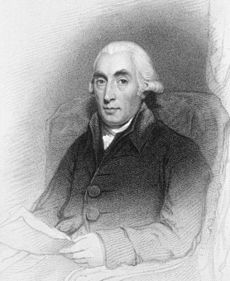Joseph Black
| Joseph Black | |
|---|---|

|
|
| Born | 16 April 1728 Bordeaux, France |
| Died |
6 December 1799 (aged 71) Edinburgh, Scotland |
| Nationality | Scottish |
| Fields | Medicine, physics, and chemistry |
| Institutions | University of Edinburgh |
| Alma mater |
University of Glasgow University of Edinburgh |
| Academic advisors | William Cullen |
| Notable students |
James Edward Smith Thomas Charles Hope |
| Known for | Latent heat, specific heat, and the discovery of carbon dioxide |
| Influenced | James Watt, Benjamin Rush |
Joseph Black FRSE FRCPE FPSG (16 April 1728 – 6 December 1799) was a Scottish physician and chemist, known for his discoveries of magnesium, latent heat, specific heat, and carbon dioxide. He was Professor of Anatomy and Chemistry at the University of Glasgow for 10 years from 1756, and then Professor of Medicine and Chemistry at the University of Edinburgh from 1766, teaching and lecturing there for more than 30 years.
The chemistry buildings at both the University of Edinburgh and the University of Glasgow are named after Black.
Black was born in Bordeaux, France, where his father, who was from Belfast, Ireland, was engaged in the wine trade. His mother was from Aberdeenshire, Scotland, and her family was also in the wine business. Joseph had twelve brothers and sisters. He attended grammar school in Belfast from the age of 12 and entered the University of Glasgow in 1746 when he was eighteen years old, studying there for four years before spending another four at the University of Edinburgh, furthering his medical studies. During his studies he wrote a doctorate thesis on the treatment of kidney stones with the salt magnesium carbonate.
Like most eighteenth-century experimentalists, Black's conceptualisation of chemistry was based on five 'principles' of matter: Water, Salt, Earth, Fire and Metal. He added the principle of 'Air' when his experiments definitely confirmed the presence of carbon dioxide (which he called 'fixed air'). Black's research programme was guided by questions relating to how the foregoing principles combined with each other in various different forms and mixtures. He used the term 'affinity' to describe the force that held such combinations together. Throughout his career he used a variety of diagrams and formulas to teach his Edinburgh students how to manipulate affinity through different kinds of experimentation.
...
Wikipedia
